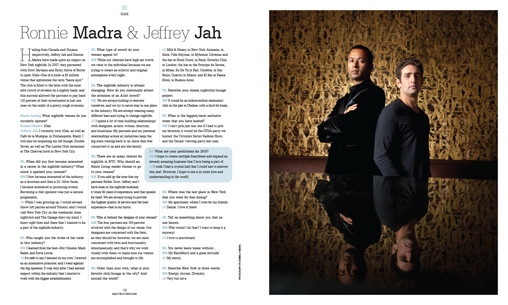“The original inspiration for the idea [of the Gramercy Park Hotel] was to try and do something that had never been done before; to break new ground and startle people. I wanted to come up with something that was completely unlike anything I have ever conceived of before,” he explains.
So how does a creative genius who has done it and seen it all before go about creating something fresh after three decades of upsetting the status quo of trends and design? Quite simply by never relenting on the quest for inspiration. Schrager describes himself as a student of culture and explains that he generates new ideas from scenes on the streets and what he senses in the air. “Replicating what someone has done before doesn’t really do anything for me. What interests me is sort of tapping into that zeitgeist,” he explains as he likens the process to a sailboat tapping into a wind and riding out the wave of air. “I like to be out there on the edge. There are signposts for ideas all around. The question is how to put them all together. It’s a matter of focusing them and trying to figure out how they fit together to create a real energy, a real explosion, like a flashpoint. That’s always interested me.”
In terms of the Gramercy Park Hotel, the signposts pointed in the direction of an intellectual artist’s loft in Manhattan. “We were very much inspired by art, as we have always been in all of our projects, and we took note that the loft, which has become the desired way of living for people in an urban environment, was really invented by artists,” he says. “Why not extend that into the hotel room as well and try and capture that kind of original, quirky idea?”
Words like eccentric and eclectic were thrown around liberally when the hotel first swung open its redesigned doors back in the winter of 2006, and Schrager’s physical manifestation of that quirky idea is demonstrated in the form of 185 rooms set in jewel tones of jade, sapphire, and ruby, with thick velvet upholstery covering the furnishings and heavy drapes curtaining the windows. Black-and-white photography from the well-known Magnum agency archives decorates the walls, with peculiar metal light fixtures throughout the property.
If his earlier partnerships with Philippe Starck conjured up images of Marie Antoinette letting them eat cake, in this partnership with longtime friend and creative master in his own right, Julian Schnabel, Schrager chose to depict an entirely different time period, reminiscent of 19th-century French bordello. Schnabel’s touch is prevalent throughout the space, as he designed a majority of the furniture and lighting, with additions from Maarten Baas and Anda Andrei. The lobby, with its checkerboard-tiled floors and 20-foot ceiling, opens up to the Rose Bar, which to some is more reminiscent of an irreverent art gallery than lounge, as works by Andy Warhol, Jean-Michel Basquiat, Cy Twombly, and Schnabel’s own Suddenly Last Summer (Picasso Painting No. 2) are on display.






















